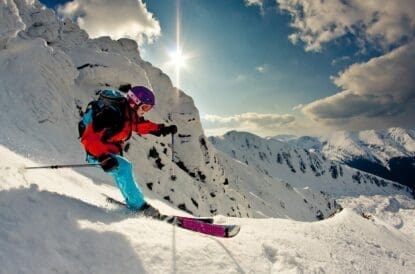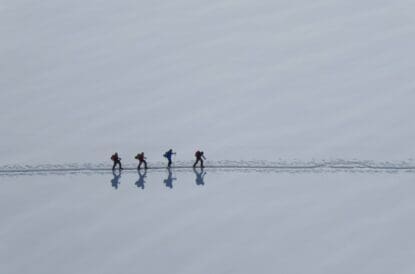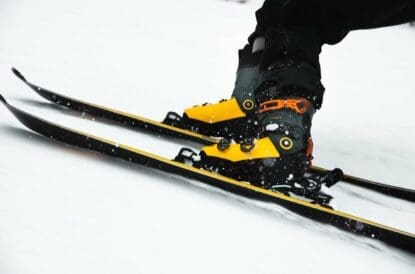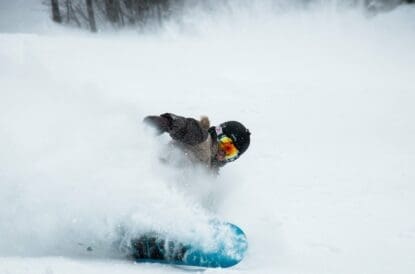Ski and snowboard gear can seem expensive, so it is important to get it right to avoid wasting money. This guide will help you pick the right ski or board jacket and work out the best layers to stay warm and dry in all conditions. For your first ski trip, it might be a good idea to borrow kit of friends and family, saving energy and money! You can also cross-purpose some other items for user on the slopes, such as sports base layers you use playing football or your favourite hoody for those extra-cold days.
However, if you’ve been bitten by the snowsports bug and can’t wait to get back to the mountains, it could then be time to start collecting your own gear to make the most of your time in the hills. Layering appropriately for different weather conditions is important, and this guide will introduce the basics of this system to help you along the way. Choosing the right ski jacket is equally important, as alongside looking awesome on the slopes, it will provide a bulk of your weather protection; some tricky, elusive terms, such as what exactly “waterproof” means, will be explained, so you can pick out the best quality jackets when gearing up!
Layering Up – The Basics
The key to staying warm – but not too warm – and dry in all conditions
One of the most important factors of ski clothing is putting layers together to achieve the best balance of warmth, waterproofing and breathability (allowing moisture vapour from sweat to pass through).
As with anything, this is just a rough guide – there is absolutely nothing wrong with throwing on your favourite hoody on cold days or rocking your coolest t-shirt to look good at lunch or après. If you ski hard, on-piste or off, you should be looking to keep to this system as much as possible, to offer you the most flexibility in different conditions.
Using a layering system such as this provides you ultimate flexibility – if the temperature varies throughout the week, you can interchange layers accordingly to ensure you’re wrapped up warm for the cold days but can shed warmth for the warmer days. If you are touring or doing a lot of backcountry that requires hiking out, the ability to shed layers on the way out or up, and then put them back on again when you stop for a break, is essential.
- Base Layer – your first next to skin layer, helping wick sweat away from your body. Not necessarily designed to provide warmth, as this comes from the other layers.
- Fleece – your next layer is a fleece, providing your first layer of warmth and another mechanism to help wick sweat away. Lighter, technical fleeces are better especially if layering over the top.
- Mid-layer – this is where your warmth comes from. A good synthetic or lightweight down layer provides exceptional warmth. Ideally still breathable, and with enough space to put layers under if needed.
- Shell – otherwise known as your ski or board jacket! This provides weather protection through waterproof and windproof elements, as well as warmth if line with insulation.
Base Layers
This is a next-to-skin layer that allows sweat to wick away easily. Merino wool base layers are ideal – they provide some warmth, including a unique fibre structure that retains warmth when wet – as well as being breathable and anti-bacterial. This last point is crucial, as it means you can wear the same base layer several times and therefore only need to pack a handful for each week’s skiing.
Traditional sports base layers, such as those you might use running or playing football, are just as good, but make sure to bring enough to wear a fresh piece every day to retain the performance of your first layer.
Fleece
Your fleece layer is the first layer that provides some real warmth. It is important your fleece layer retains some breathability, however, so a big, bulky piece of kit is probably not ideal here. Traditional Polartech fleeces are ideal, but modern fleeces are lightweight and infused with all sorts of technology to provide a better fit or to spread water around the surface, helping it dry quicker.
Mid-Layer
This is the most important layer for warmth. Mid-layers can be divided up into two categories based on the materials they are made of – synthetic or natural goose/duck down.
Synthetic mid-layers are best for skiing as they provide plenty of warmth whilst being breathable. The insulation is created by weaving together fibres, creating a matting very similar to loft insulation. They should provide plenty of space underneath to add more layers if needs be.
Goose or duck down mid-layers need to be carefully selected. Down layers can be seriously warm – great if you are going somewhere cold and standing still, but not so good when you are moving and generating your own body heat. Your everyday, around town down jacket will also be too bulky to fit under a ski jacket and over other layers. With down, lighter is often better – both because good quality down material is significantly less dense than poor quality with the same weight of down providing far more warmth, and because a thinner down jacket will regulate your temperature much more effectively.
Remember, look for symbols like the RDS tag – Responsible Down Standard – to ensure that any down used in an item is produced with the welfare of the animals in mind.
Shell
Your shell, sometimes called a hard shell, outer shell, or simply ski jacket, is, as the name suggests, your outer layer, designed to provide most of the weather protection, as well as some warmth. Jackets need to be tough, and provide plenty of space for layers underneath, so it is important to get a snowsports specific jacket – your Barbour or an about-town Harrington jacket simply won’t cut it in the mountains.
It is essential that your shell is waterproof, or at least highly water resistant. Anything that is waterproof will be windproof as well, so will provide additional protection on the higher lifts and above the treeline. Most reputable ski brands build their jackets to be well above the minimum legal standard for waterproofing, so will work very well.
Two other factors should be considered when looking for your new jacket:
- Insulation – most people opt for a jacket with insulation, making it a nice and warm piece to throw on in the cold of the mountains. This is normally the equivalent of a mid-layer – if you are a performance skier, tourer or backcountry adventurer, or you ski at many different times of year, it may better to choose one without insulation, known as a “shell”, and replace the warmth lost with a mid-layer when necessary.
- Breathability – as with your other layers, you want your ski jacket to allow moisture vapour and heat out, otherwise you’ll overheat on the slopes. This is achieved in two ways in combination with waterproofing – either a plastic coating or a breathable membrane, such as Gore-Tex. Breathability is measured in volume of vapour allow to pass through the material in a 24hr period – a good standard is around 20,000 cubic millimetres, and, similar to waterproofing, this standard aimed for by many ski brands.
Ski Trousers
Much less layering is needed for your legs, as they are doing a lot more work and therefore will generate much more warmth.
Your trousers, similar to your ski jacket, needs to be a snowsports specific model – big, to provide plenty of freedom of movement for your legs, and tough, to protect you from rocks, trees, wind, rain, snow, and sitting down on cold and damp surfaces such as on a chairlift. insulation is similarly optional, as many people find their legs are working hard, and therefore generating warmth, as well as not feeling the cold so much overall.
Base layers are available and recommended, as it will wick sweat away as well as provide warmth – merino wool is again best, but synthetic sports base layers are equally good.
Mid-layers do exist for your legs, but a generally considered overkill when you are skiing – they are designed for going somewhere cold and standing still more than being active. Instead, insulated snowsports trousers will fill this role nicely.
The final thing to consider is whether you need salopettes or not – these are ski trousers with a usually built-in set of braces that come over the shoulders and help keep the trousers held up. Usually with a “bib” at the front, they can provide a really useful extra bit of protection to stop snow and water from getting in if you were to have fall, especially in powder.
Summary
When picking out gear in a shop, remember:
- A layering system means you are prepared for changing conditions and skiing intensities
- Merino wool base layers are often better for skiing – their unique anti-bacterial nature means you only need a handful for a week’s skiing
- Your ski jacket or shell provides most of your wind and weather protection
- Legs do more work and generate more heat than your torso – less insulation is therefore required, but a merino baselayer is still recommended






